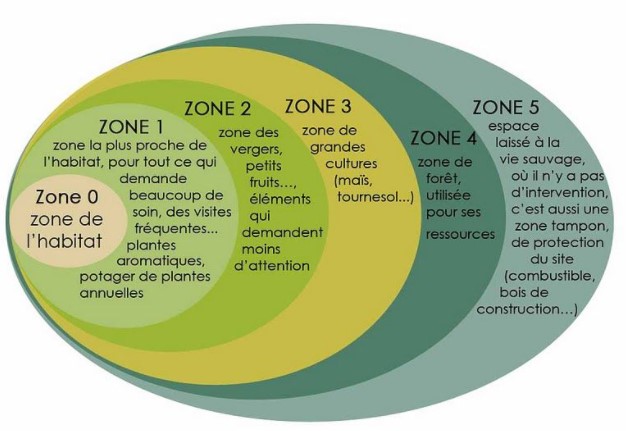Permaculture
 Permaculture principles, techniques, ethics, layout, ...
Permaculture principles, techniques, ethics, layout, ...


Permaculture is a way of looking at an ecosystem as a whole, observing the interactions between its components, and seeking to integrate human activities while respecting natural processes. It implies respect for nature, for example by reducing waste and replacing biocides with natural control methods. It applies just as much to the redevelopment of a vast industrial estate as it does to an individual farm. Permaculture is a way of thinking and a vision of the world that for some goes beyond agricultural production practices.
Description
Permaculture originally meant "permanent agriculture", but over time it has been extended to mean "the cultivation of that which is permanent (in the sociological sense), perennial or viable". The social aspects are an integral part of a truly sustainable system.
In this extended sense, permaculture trains individuals in an ethic and a set of principles. Theaim is to enable these individuals to design their own environment, and thus create more autonomous, sustainable and resilient human habitats, drawing inspiration from local natural processes. The idea is to achieve a society that is less dependent on industrial production and distribution systems.
Permaculture uses concepts such as ecology, landscape,organic farming, agroecology, biomimicry, ethics, philosophy and soil science. Permaculture invites us to relate these theoretical aspects to observations made in the field in a harmonious way.
Permaculture ethics
Permaculture is based on an ethic. This is a set of fundamental values which govern thinking and action. The permaculture ethic can be summarised as follows :
- To care for nature (soil, forests, water and air) : Use it to feed ourselves while altering its natural functioning as little as possible. To do this, take inspiration from the way in which wild ecosystems function, also drawing on scientific innovations in the natural sciences.
- Taking care of people (ourselves, the community and future generations) : In particular, by drawing inspiration from the techniques used by the first peoples, which are perfectly adaptable to our current technologies, contrary to popular belief, and have far more ethical, effective and sustainable applications.
- Share fairly, limit consumption and reproduction and share the surplus.
In practical terms, permaculture is the direct application of biomimicry, i.e. taking inspiration from the way nature works and reproducing it, adapting it if necessary.
Permaculture principles
Permaculture is based on meticulous observation of the efficiency of natural ecosystems in order to derive universal guiding principles. Each permaculturist can add new principles that enrich those of the origins.
Among these principles, drawn from the observation of resilient natural systems, we can cite : In simple terms, practise fair trade when you have production surpluses.
The basic principles
- Observe and interact.
- Capture and store energy.
- Produce output.
- Use and develop renewable & organic services and resources.
- One person's waste is another person's resource.
Favour small, intensive systems and slow solutions.
- Use and value diversity.
- Use and enhance the edge effect.
A job to be done is the result of a need not met by the system you have created.
Philosophical principles
- Integrate rather than separate.
- The problem is the solution.
- Accept feedback and limitations and react creatively.
- Garden everything.
- Work with nature, not against it.
- Small actions make big changes.
- Take responsibility for your own life.
Design principles
- Start with the overall structure and work down to the details.
- Each element fulfils several functions.
- Each function is fulfilled by several elements.
- Conserve energy (recycle, circulate and optimise).
- Accelerate evolution and succession.
- Each element is placed according to its relationship with the others.
- Plan for energy efficiency.
- Start at the doorstep.
- Start small, then expand if necessary.
- Apply self-regulation and accept feedback.
Space planning
Spatial planning, or zoning, is fundamental to permaculture.
Permaculture zones are interlocking circles where the development of a space depends on its distance from the centre. The further the zone is from the centre, the more the economic viability of certain types of production will diminish. The centre is often the home in permaculture. It should be noted that it is not so much economic viability as the reduced use of energy that leads to the organisation of space.
Permaculture zones are defined according to their frequency of use, i.e. the frequency of travel required to access them. There are generally 5 or 6 zones, depending on whether the house is placed in the centre or not. Zones that are less frequently harvested or visited are located further away.
The 6 zones are :
- Zone 0 : the house itself.
- Zone 1 : the garden and elements requiring daily, sustained attention.
- Zone 2 : the orchard and barnyard.
- Zone 3 : pastures and cereals. This production tends to be more sales-oriented.
- Zone 4 : pastures and woods. This zone is often left to native plants.
- Zone 5 : wilderness. Human intervention is limited to the harvesting of useful spontaneous plants.

La technique est complémentaire des techniques suivantes
To go further
- Permaculture etc.
- Beginning permaculture - Permaculture Design
- Permaculture - La ferme du Bec Hellouin
- Permaculture - Healthy planet
- DEFINITION OF PERMACULTURE. - Towards autonomy